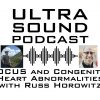This week we get to hear from Cian McDermott, ED physician extraordinaire on his approach to cardiac arrest. In this podcast we discuss 1 vs 2 person POCUS, different ways to use it during arrest, and some of our favorite published protocols. There was so much great content in this interview, so I decided to break it up into 2 podcasts. This week features part 1! (Click here for Part 2)
Look down below for the show notes, courtesy of Cian McDermott!
Important topic – why?
- work in ED see several OOHCA per week
- my service 3 to 5 per week
- 10 – 15% survival rate in best centres (Danish 15 yr study)
- can we manage this better using POCUS?
- Concept has been around but lots of new literature in 3 years
Caution
- POCUS is not for shockable rhythm
- put down the transducer and give electricity!
- conside for reversible arrest only = PEA, asystole (5Hs & 5Ts)
2 user levels
Level I user – most ppl
- US during pulse check only
- SubX window
- maybe confirm asystole at end
- first time I saw POCUS in code like this was in Australia in 2014
Level 2
- may have been to EGLS course
- looking for reversible causes
- tamponade, signs RV strain then cardiac activity
- SubX or PSLA view
- starts before the end of CPR to minimise delays
What does the evidence say?
- ACLS from 2015 cites a single study and they recommend that US may be used during an arrest, they give class II evidence for this
- I had to hunt on the website to find this – ACLS are ‘lukewarm’
- ACLS will be updated in 2020 so I’m waiting to see what changes are recommended
- European and American Society produced guidelines on use of POCUS
- Huis published a paper in that involved filming an actual arrest scenario and then measuring times involved (Huis In ‘t Veld et al. 2017)
- group that used POCUS had 21s for the pulse check
- group that did not use POCUS had 13s pulse check
- discussed this on UltrasoundGEL podcast in 2017
- raises important question – are we causing delays by using POCUS?
- Need to do it better consistently
- Romolo Gaspari’s paper from the REASON network (Gaspari et al. 2016)
- Gaspari was interviewed about this on ultrasound podcast at time of publication
- changes the way I think about POCUS in a code
- 20 sites, almost 800 patient *asystole *PEA *out of hospital or in ED * did scan #1 at start and scan #2 at end of code
- If you have activity on US then associated with survival to discharge OR 5.7
- If no cardiac activity – 0.6% survival rate to discharge
- How does this help IRL? Helps us prognosticate – help decide if we should stop
- Asystole is wrong 10% cases – there was cardiac activity on the 1st US
- PEA has cardiac activity in 54% cases – may not be pulseless
- justifies the use of POCUS every time in a code
- CASA protocol from Arun Nagdev’s group in Highland (Clattenburg et al. 2018)
- Cardiac Arrest Sonographic Activity study
- Really neat protocol that fits right into ACLS framework
- Check for tamponade at 1st pulse check (10s)
- Next pause, look for RV strain pattern
- Next pause look for cardiac activity
- Post implementation data how some great reductions in pulse check duration in their – 4s on average when this protocol was used
- Solves the delay in pulse check problem for me
Another protocol in the Australian literature that was published in 2019
- COACHRED menemonic (Finn et al. 2019)
- (Stands for Continue compressions, Oxygen support, All else stand clear, Charge Defib, Hands off compressions)
- Then the US piece Rhythm check, Record Echo, then off, deliver shock or dump the charge
- Simulation based protocol
- Main difference with this one is that it is used for shockable and non shockable arrests so that’s why the sono person stands clear for the shock
- Another great algorithm that integrates to ACLS but they advocate that only echo during the pulse check – I disagree there is lots more info from intra-arrest ECHO
- Great to specify a sequence of events in a code for all users
That pig study 2016 (Anderson et al. 2017)
- VF induced in 2 group of pigs – the group that had CPR performed over centre of LV had inc rate of ROSC and better ETC02 readings
- group that had CPR over aortic root did worse
- Standard position is in centre of the chest – should we tailor CPR based on LV compression & recoil that you see if you use intra-arrest CPR
- YES, why not!
- Extrapolate to humans = caution
Lots of other ELS acronyms
- FATE = focussed assessed transthoracic echo *early one
- FEEL = focussed echo in emergency life support *UK based exam
- FEER = focussed echo in evaluation of resuscitation
- CAUSE = cardiac arrest US exam
Where do I go if I want to read more about this area? Are there any high-yield papers about this?
2 great papers about it POCUS at a CODE
- Rachel Liu from Yale – published last year in prehospital journal – really practical tips on the ‘how to’ of POCUS in a code plus 5 amazing cases (Liu et al. 2019)
- Laila Hussein’s paper just hot off the press at the end of December – great run down of key topics (Hussein et al. 2019)



